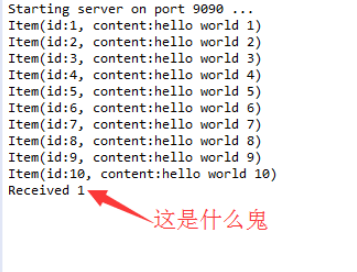您好,登錄后才能下訂單哦!
您好,登錄后才能下訂單哦!
今天給大家介紹一下如何分析Thrift示例。文章的內容小編覺得不錯,現在給大家分享一下,覺得有需要的朋友可以了解一下,希望對大家有所幫助,下面跟著小編的思路一起來閱讀吧。
demo.thrift 文件內容如下
namespace java com.vv.test
struct Item {
1: i64 id,
2: string content,
}
service CrawlingService {
void write(1:list<Item> items),
}
使用命令自動生成文件
F:\>thrift-0.10.0.exe --gen java demo.thrift
然后拷貝到項目
然后編寫樣例代碼
<ol start="1" class="dp-j" white-space:normal;">
"hello world " + i);
list.add(item);
}
client.write(list);
}
}
// Set port
TServerSocket serverTransport = // Set CrawlingHandler we defined before
// to processor, which handles RPC calls
// Remember, one service per server
CrawlingHandler handler = "Starting server on port 9090 ...");
server.serve();
} "localhost", 9090);
transport.open();
TProtocol protocol = new TBinaryProtocol(transport);
CrawlingService.Client client = new CrawlingService.Client(protocol);
client.write(items);
transport.close();
} catch (TTransportException e) {
e.printStackTrace();
} catch (TException e) {
e.printStackTrace();
}
}
}
class CrawlingHandler implements CrawlingService.Iface {
@Override
public void write(List<Item> items) throws TException {
for (Item item : items) {
System.out.println(item);
}
};
}
執行結果如下:

但是輸出的最后一行顯示"Received 1" ,這個輸出是從哪里來的?以后慢慢再看吧.
以上就是如何分析Thrift示例的全部內容了,更多與如何分析Thrift示例相關的內容可以搜索億速云之前的文章或者瀏覽下面的文章進行學習哈!相信小編會給大家增添更多知識,希望大家能夠支持一下億速云!
免責聲明:本站發布的內容(圖片、視頻和文字)以原創、轉載和分享為主,文章觀點不代表本網站立場,如果涉及侵權請聯系站長郵箱:is@yisu.com進行舉報,并提供相關證據,一經查實,將立刻刪除涉嫌侵權內容。